When you're capturing microscopic details, your camera control software can make or break the quality of your images. You'll find countless options available, but not all will deliver the precision and features you need for professional-grade microscope photography. From real-time previews to advanced measurement tools, the right software transforms your microscope into a powerful imaging system. Let's explore five standout solutions that'll help you capture those intricate details with confidence.
Skybasic 50X-1000X WiFi Digital Microscope with Adjustable Stand
The Skybasic 50X-1000X WiFi Digital Microscope is an ideal entry-level tool for hobbyists, students, and casual users who need versatile microscope photography capabilities. You'll capture images at up to 1080p resolution on smartphones and 720p on computers using the 2MP HD CMOS sensor.
This microscope connects to your devices through WiFi or USB, supporting both iOS and Android via the Max-see app. For Windows and Mac users, you'll need specific software like AMCap or Photo Booth. The 8 adjustable LED lights help you achieve maximum clarity, while the magnification range of 50X-1000X lets you examine specimens in detail. Though the adjustable stand has some stability issues, the microscope's lightweight design makes it portable for field use.
Best For: Students, hobbyists, and casual users seeking an affordable digital microscope for basic specimen examination and educational purposes with smartphone/computer connectivity.
Pros:
- High versatility with WiFi and USB connectivity options for multiple devices (iOS, Android, Windows, Mac)
- Good image quality with 1080p resolution on smartphones and adjustable LED lighting
- Portable and lightweight design makes it suitable for field use and educational activities
Cons:
- Stand stability issues when used handheld can affect image quality
- Software compatibility requirements may be confusing for some users
- Not suitable for professional or advanced scientific research due to limited capabilities
Wireless Digital Microscope 50x-1000x with USB HD Camera
Versatile and user-friendly, this wireless digital microscope offers an ideal solution for hobbyists, educators, and casual explorers who need detailed visual inspection capabilities without complex setups.
You'll get 50x-1000x magnification with 1080P HD imaging for smartphones and 720P for computers. The device connects via WiFi to phones or USB to computers, supporting iOS, Android, Windows, and Mac platforms. Its 8 adjustable LED lights guarantee clear visibility in dark conditions.
The compact 7.8-ounce unit includes a rechargeable battery lasting 3 hours per charge. While it's not meant for professional research, you'll find it perfect for examining plants, electronics, or collectibles. The package includes a stand, base, and USB cable for immediate use.
Best For: Hobbyists, students, teachers, and casual enthusiasts who need basic magnification for examining collectibles, plants, or electronics without requiring professional-grade microscopy capabilities.
Pros:
- Easy setup and versatile connectivity options with both WiFi for mobile devices and USB for computers
- Adjustable LED lighting system helps capture clear images in various lighting conditions
- Portable and lightweight design with rechargeable battery making it convenient for field use
Cons:
- Not suitable for professional or serious biological research applications
- Some users report connectivity issues and software freezing problems
- Sensitive adjustment dials and stability requirements can make it challenging to capture clear images
SVBONY SV189 Digital Microscope Camera
Designed with beginners and educators in mind, SVBONY's SV189 Digital Microscope Camera offers an entry-level solution for microscope photography at 1.3 megapixels. You'll find it compatible with both 23.2mm and 30mm eyepiece sizes, making it adaptable to most standard microscopes.
The camera comes with essential software for editing, measurement, and data export, supporting both Windows and Mac OS platforms. While you'll appreciate its user-friendly setup and affordable price point, be aware that some users report software installation challenges with Windows 10. If you're just starting with microscope photography, this camera provides decent value, though serious users might want to reflect on higher-resolution alternatives.
Best For: Entry-level microscopists, students, and educators seeking an affordable digital camera solution for basic microscope photography and documentation.
Pros:
- Easy setup and compatibility with most standard microscope eyepieces (23.2mm and 30mm)
- Includes comprehensive software for image editing, measurements, and data export
- Budget-friendly price point ideal for beginners and educational settings
Cons:
- Limited resolution at only 1.3 megapixels, which may not satisfy advanced users
- Some users experience software installation difficulties with Windows 10
- Field of view and image quality issues reported due to potential lens size mismatches
Digital Microscope Camera with HDMI & USB, 48MP Full HD
Professional microscopists seeking high-resolution imaging will find exceptional value in this 48MP digital microscope camera with dual HDMI and USB connectivity. You'll get crisp 2.7K video at 30FPS or 1080p at 60FPS through HDMI output.
The camera's versatility shines with its C-mount adapters (25mm, 30mm, and 30.5mm) and Windows-compatible software for editing, processing, and image stitching. While it works with both Windows and Mac systems, you'll need to verify Mac compatibility first, as some users report software limitations. The 1/2.33-inch CMOS sensor delivers impressive detail, though you'll need HDMI connection to access the full 48MP resolution.
Best For: Professional microscopists and researchers who need high-resolution imaging capabilities with flexible output options and are primarily using Windows-based systems.
Pros:
- High-resolution 48MP imaging capability with 2.7K video output at 30FPS
- Versatile connectivity with both HDMI and USB outputs
- Includes multiple C-mount adapters (25mm, 30mm, and 30.5mm) for broad compatibility
Cons:
- Limited software functionality and compatibility issues with Mac systems
- Maximum resolution only available through HDMI connection
- Mixed customer reviews regarding image quality control and white balance
Swift 5.0 Megapixel Digital Camera for Microscopes
Entry-level microscopists and hobbyists will find the Swift 5.0 Megapixel Digital Camera a practical choice for basic microscope imaging. You'll get decent color photos and video streaming at 10-15 fps through its USB 2.0 connection, though the field of view covers only about 1/4 of what you'd see through the eyepiece.
The included Windows software offers helpful features like image stitching and measurement tools, but Mac users should consider alternative apps. While the camera works well for educational purposes, you'll want to look elsewhere for serious lab work. Despite its limitations, including slow response times and adapter tube issues, this camera delivers reasonable value at its price point.
Best For: Entry-level microscopists, students, and hobbyists seeking an affordable digital camera solution for basic microscope imaging and documentation.
Pros:
- Easy to use with Windows-compatible software offering helpful features like image stitching and measurement tools
- Compact and lightweight design with universal microscope compatibility
- Good value for basic microscopy needs with decent 5MP image quality
Cons:
- Limited field of view (only 25% of what human eye sees through microscope)
- Slow frame rate (10-15 fps) may not be suitable for capturing dynamic subjects
- Software compatibility issues for Mac users and lacks proper adapter tube locking mechanism
Factors to Consider When Choosing Camera Control Software for Microscope Photography
When selecting microscope camera control software, you'll need to check its compatibility with your operating system and verify important features like image processing capabilities and file format support. You should confirm the software provides reliable live preview functionality, which is essential for focusing and framing your microscopic specimens. The inclusion of measurement tools is also important, as you'll likely need to analyze and document the size of various microscopic structures in your images.
Operating System Compatibility
Operating system compatibility stands as one of the most critical factors in selecting microscope camera control software. You'll need to verify that your chosen software works seamlessly with your specific Windows or Mac OS version, as functionality can vary considerably between platforms.
While many applications support both operating systems, you'll find that some features may be limited or unavailable depending on your platform. Windows users might get access to advanced editing tools that aren't available to Mac users. Before making your purchase, it is vital to test the software's stability on your system if possible.
Don't forget to check user reviews specifically related to your operating system, as they often reveal compatibility issues that emerge after system updates. This extra research can help you avoid installation problems and guarantee smooth operation.
Image Processing Features
Selecting the right image processing features can make or break your microscope photography workflow. You'll want software that offers advanced editing capabilities like image stitching and extended depth of focus to produce high-quality microscopic images.
Look for measurement tools that enable precise analysis of your specimens – they're essential for both educational and research applications. You'll also benefit from features like annotation tools to mark important details and batch processing to handle multiple images efficiently.
The software's interface should be intuitive and easy to navigate, allowing you to focus on your work rather than struggling with complicated controls. Don't forget to check for specialized functions that match your specific needs, whether you're conducting detailed research or creating educational materials for students.
File Format Support
Extensive file format support stands as an essential factor in microscope photography software. You'll want software that can handle common formats like JPEG, PNG, and TIFF to guarantee your images remain high-quality and compatible with various editing programs.
If you're serious about microscope photography, look for software that supports RAW formats. This gives you more control over post-processing adjustments like exposure and white balance without compromising image quality. Additionally, you'll benefit from software that includes robust file organization and metadata management features to efficiently handle large image collections.
For those planning to capture microscope videos, make sure your chosen software supports formats like AVI or MP4. These formats will make it easier to share and play back your footage across different platforms.
Live Preview Capabilities
When evaluating microscope camera control software, live preview capabilities should rank high on your priority list. You'll want a system that displays smooth, real-time feeds from your microscope camera, allowing you to make immediate adjustments to focus, lighting, and specimen positioning.
Look for software that offers responsive performance with minimal lag, as this directly affects your workflow efficiency. The best programs let you adjust exposure settings, white balance, and other parameters while viewing the live feed. You'll also need to verify the software is compatible with your operating system to achieve peak preview performance.
Consider how the live preview quality impacts your ability to assess specimens accurately. High-quality previews will help you capture better images by letting you perfect all settings before taking the final shot.
Measurement Tool Options
The measurement capabilities of microscope camera software can greatly impact your research accuracy and efficiency. You'll want to guarantee your software includes essential measurement tools for linear distances, areas, and angles to effectively analyze your specimens.
Look for software that offers calibration features, which let you set accurate measurement scales using known reference distances. If you're handling multiple specimens, automated measurement functions will save you significant time. You'll also benefit from overlay tools like grids and rulers that display directly on your captured images.
Don't forget to check file format compatibility – your software should support common formats like JPEG and TIFF. This guarantees you'll be able to preserve measurement data and seamlessly integrate your findings with other analytical tools in your workflow.
Multi-Device Integration
Modern microscope photography demands software that works flawlessly across multiple devices and platforms. When selecting your camera control software, you'll want to confirm it's compatible with both Windows and Mac operating systems to maintain flexibility in your workflow.
Look for software that offers mobile device integration through WiFi-enabled apps, allowing you to control your microscope camera remotely from your smartphone or tablet. You'll need support for various connection types, including USB and HDMI, to efficiently transfer and display your microscopic images and videos.
Choose software with an intuitive interface that you can easily navigate across different devices. Don't forget to verify that the developer provides regular updates and support to maintain compatibility with new devices and operating system versions, confirming your investment remains valuable over time.
Data Export Functions
Effective data export capabilities serve as the backbone of any reliable microscope camera control software. You'll want software that offers flexible file format options to guarantee your captured images and videos remain compatible with your preferred analysis tools and systems.
Look for solutions that include batch export features, which will save you valuable time when transferring multiple files. The software should also preserve important metadata, including magnification settings, lighting parameters, and camera configurations alongside your images.
When selecting your software, prioritize options that integrate smoothly with your existing data processing applications. A user-friendly export interface will streamline your workflow, reducing the time you spend managing files and allowing you to focus more on your microscopy work.
Resource Usage Requirements
When selecting microscope camera control software, you'll need to carefully evaluate its resource usage requirements to confirm smooth operation on your system. Check your operating system compatibility first, as software may only work with specific Windows or Mac OS versions.
Pay attention to the minimum RAM and CPU specifications, especially if you're working with high-resolution images that demand more processing power. Your software should efficiently handle image stitching and calibration tasks without overwhelming your system resources.
Don't forget to read user reviews about real-world performance. They often reveal resource-related issues that aren't mentioned in product specifications. Look for software that provides effective data management features to streamline your workflow while maintaining peak system performance. This balance ensures you can capture and process images without experiencing slowdowns or crashes.
Frequently Asked Questions
Can I Use Multiple Microscope Cameras Simultaneously With One Software?
Yes, you can operate multiple microscope cameras at once with software like Micro-Manager or MetaMorph. They'll let you control and capture images from different cameras simultaneously through a single interface.
How Often Should I Calibrate My Microscope Camera for Accurate Measurements?
You'll need to calibrate your microscope camera whenever you change magnification levels, at least monthly for routine use, and before any critical measurements. Regular calibration guarantees your measurements stay accurate and reliable.
What File Formats Are Typically Supported for Microscope Image Storage?
You'll typically find microscope images stored in TIFF, PNG, or JPEG formats. TIFF is preferred for scientific work as it's lossless, while JPEGs are more compact but lose some quality during compression.
Are There Smartphone Apps Compatible With Microscope Camera Control Software?
You'll find several smartphone apps that work with microscopes, like ScopeImage, MicrobeHunter, and Microscope Camera. They let you capture, store, and share images directly from your microscope through your phone.
Does Microscope Camera Software Work With Both Windows and Mac Operating Systems?
You'll find most microscope camera software works with Windows, but compatibility varies for Mac. It's best to check specific software requirements, as some popular options like Motic Images Plus support both operating systems.
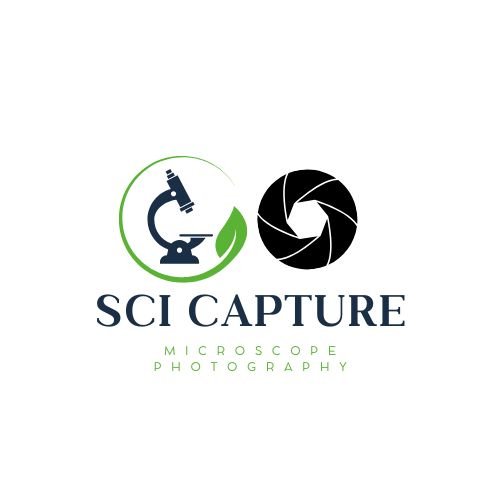
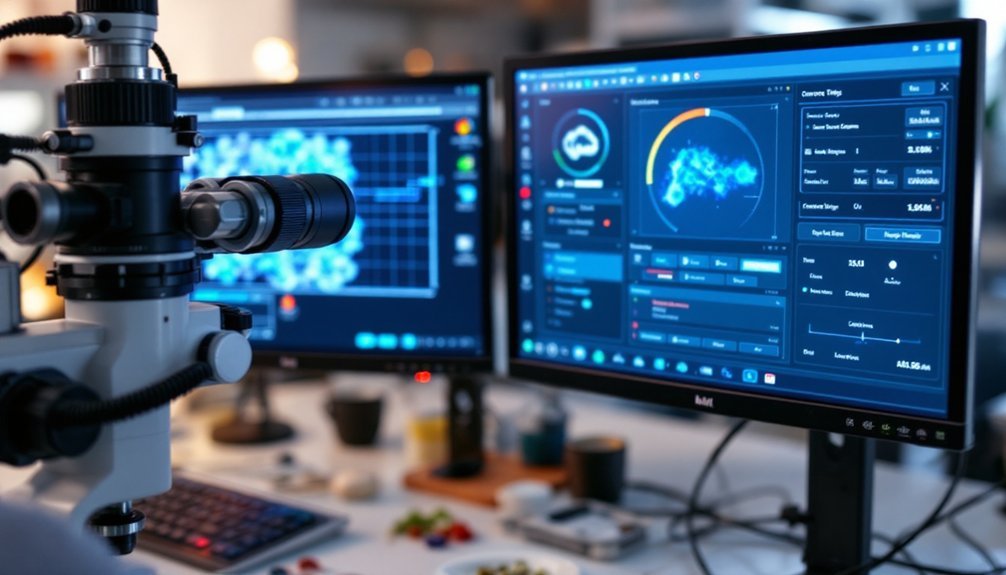
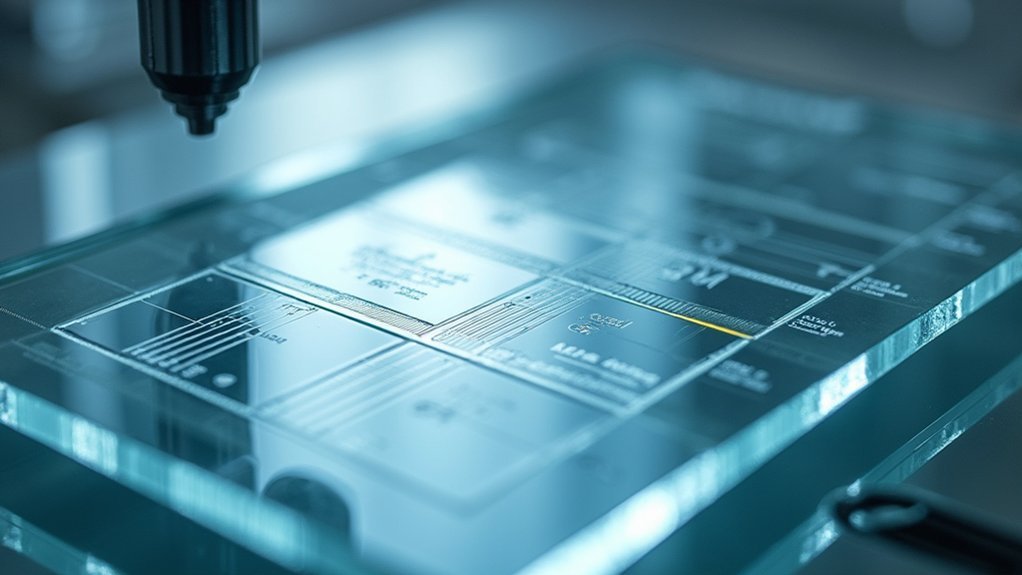
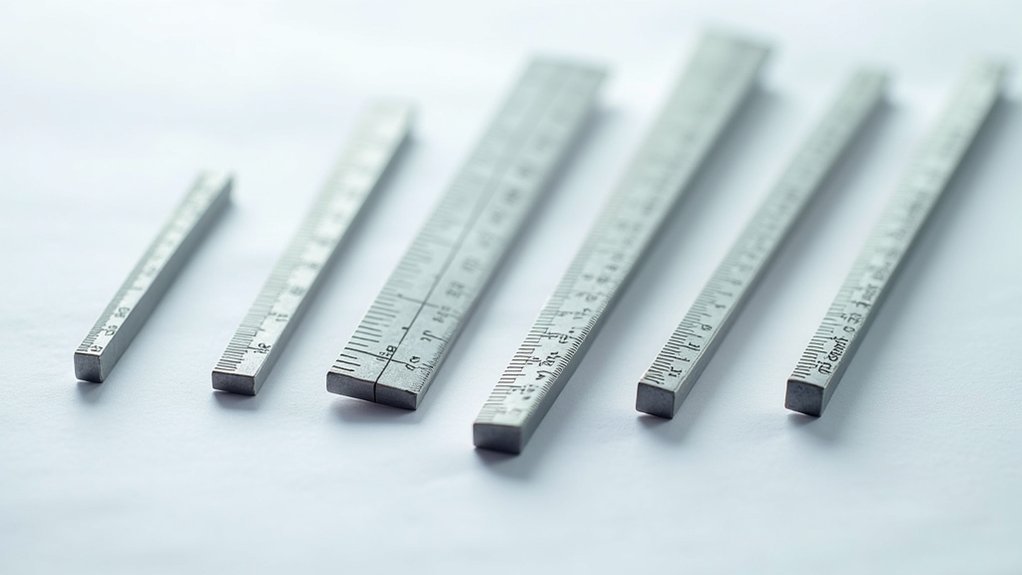
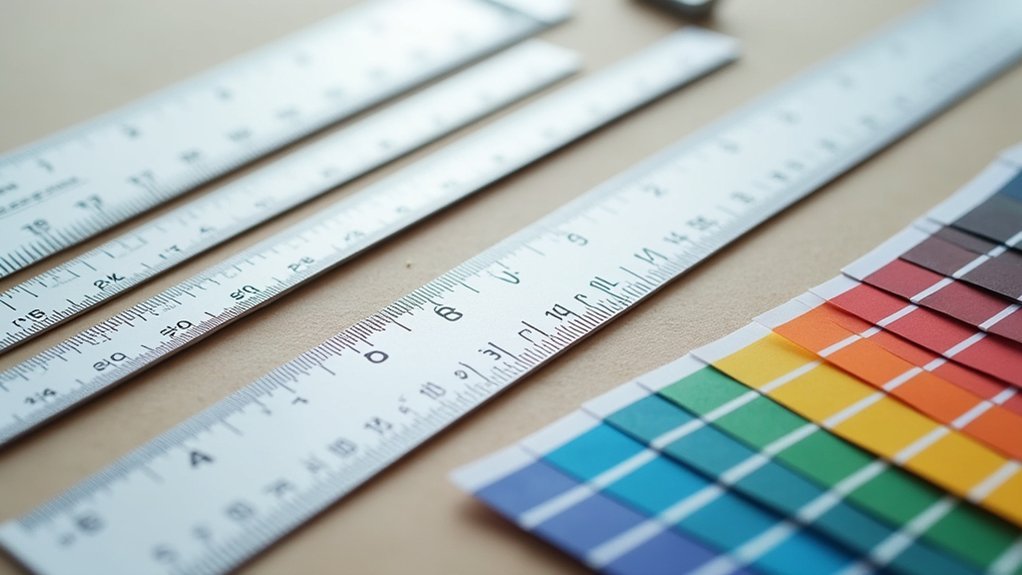
Leave a Reply